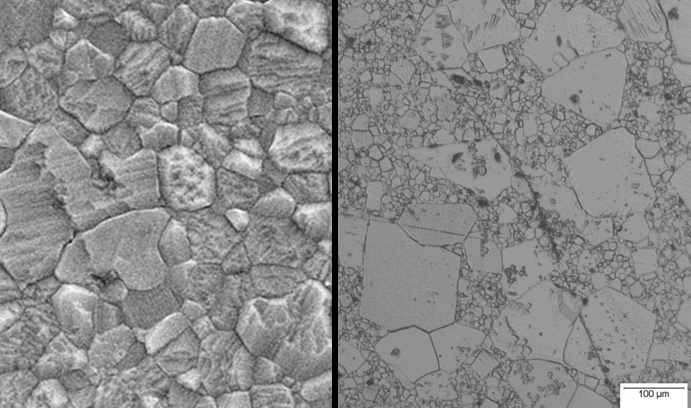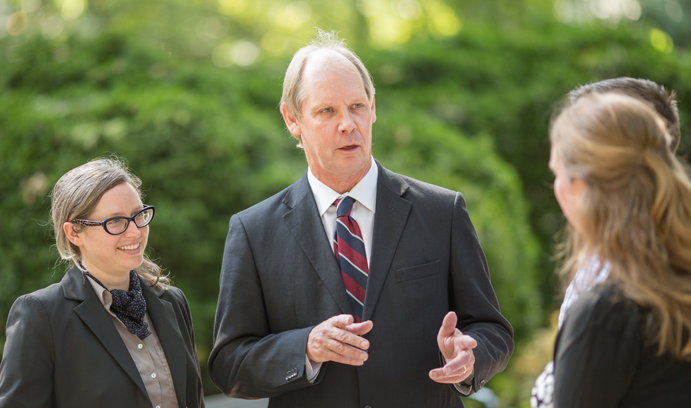A Safer Method of Decontaminating Ceramics

Ceramic powders made using Kundu and Harmer’s pretreatment process (left) show greater consistency in grain sizes than powders fabricated conventionally.

In his new role as senior faculty adviser for research initiatives, Harmer will support junior faculty in shaping their research into competitive funding proposals.

In his new role as senior faculty adviser for research initiatives, Harmer will support junior faculty in shaping their research into competitive funding proposals.
On Martin Harmer’s office table sits a crystalline cube that looks like a glass coaster but is actually a piece of magnesium aluminate spinel, whose qualities make it eligible for a range of uses, from a superior optical material for lasers to a window material half the weight of bulletproof glass that can withstand projectiles.
“It takes a great deal of effort to make it this clear and sharp,” says Harmer, who has spent three decades tailoring the properties of ceramics and metals at the atomic level. “We have to heat-treat it for a long time to get rid of the impurities. As a result, the material weakens.”
Harmer’s latest work involves an innovative way to decontaminate ceramic material and strengthen its fundamental nanostructure. Improving the processing techniques is crucial, because ceramics are the building blocks of many products, including the powder-based polymers used in selective laser sintering (SLS), a rapid 3D printing method.
Ceramics are made by applying heat and pressure to pack together separate grains. Understanding the properties of the boundaries between the bonded crystals, which are only a few atoms wide, is the key to engineering the desired materials.
“Like bricks on a house, where the polycrystalline grains meet represents an important region that can determine the properties of the material as a whole,” says Harmer, professor of materials science and engineering. Characterizing these grain boundaries can help overcome abnormal grain growth and other problems. Lehigh’s uniquely powerful electron microscopes are indispensable to observing the behavior of ceramics particles at the nanoscale, Harmer says.
“There are still a lot of mysterious things going on at the nanoscale, at the grain boundaries, that we don’t fully understand. An example is anti-thermal behavior. That’s when the atoms move faster at cooler temperatures and slow down at higher temperatures.”
Like other physical materials, grain boundaries have their own phases and properties, for which Harmer has coined the collective term “grain complexion,” and which can be fine-tuned.
Changes in the complexion can lead to abnormal grain growth and embrittlement, so the ceramics industry is striving to produce high quality ceramic powders with a uniform grain size and without contaminants.
The usual way to remove impurities in ceramics involves adding a dopant, or additional compound. However, the typical dopant used in industrial processes, lithium fluoride, weakens the overall material and degrades its optical properties over time. And removing impurities is a sensitive process. “A difference of a few tens of parts per million of common elements can have a profound impact on the properties of the material,” Harmer says.
Working with Lehigh research scientist Animesh Kundu, Harmer has invented a pretreatment process that strengthens ceramic powders and removes impurities without adding dopants. The method exposes the powder to an ultra-high vacuum and low temperature, effectively detaching and evaporating any solid impurities to a gaseous state. This part of the process has a simple beauty, similar to the way dry ice changes phase directly to vapor, Harmer says.
The innovation has the potential to improve the ceramic materials that are used in the aerospace and defense industries, and it represents the only successful effort to date to purify ceramic powders without altering their physical characteristics.
The two scientists won a National Innovation Award for their project, titled “A Novel Decontamination Process for Powders for Transparent Ceramics,” at the 2014 TechConnect World Conference and Expo in Washington, D.C.
Posted on:


